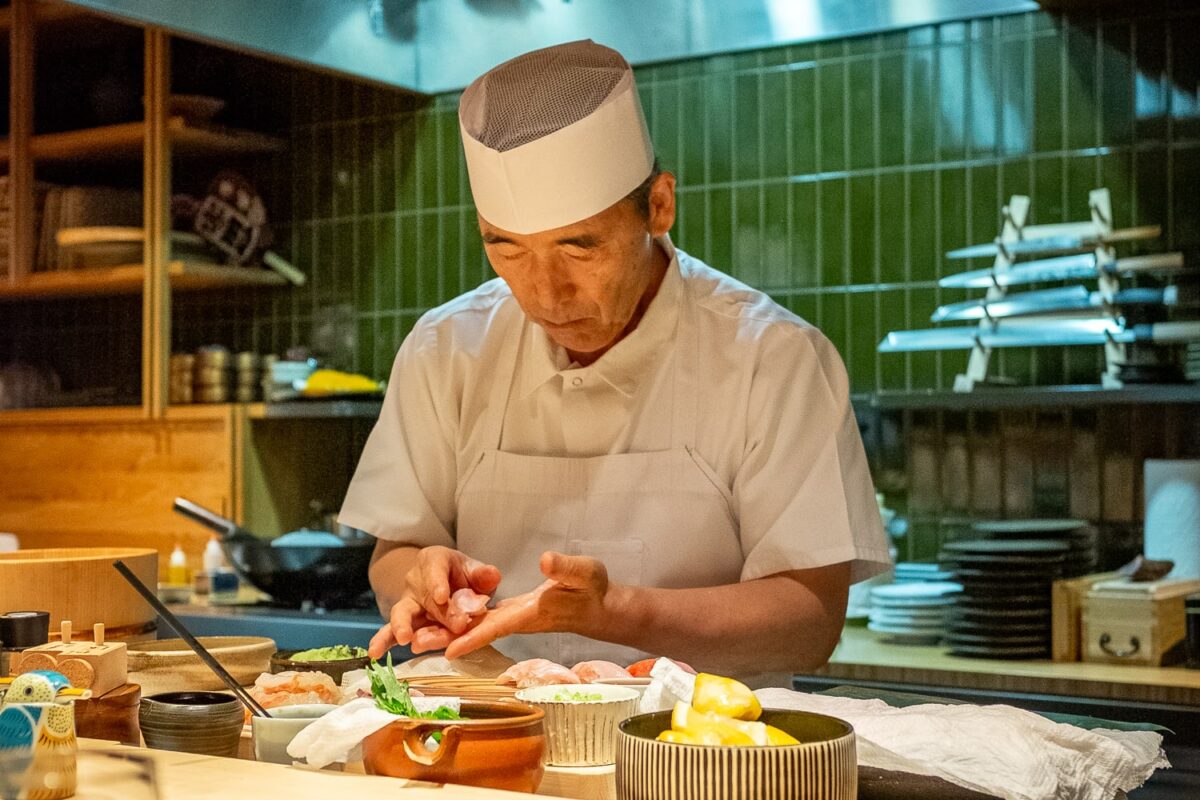Editor’s Note: On September 15, 2025 the Michelin Guide awarded Kizaki One MICHELIN Star. I visited the restaurant in July 2025.
Denver restaurateur Toshi Kizaki — known for running several of the city’s most popular Japanese eateries – has opened a new, eponymous omakase counter, Kizaki. At 70 years old, he works on‑site four nights a week, personally overseeing the kitchen and guiding diners through a meticulously curated 20‑course tasting menu that distills four decades of sushi mastery into a single, focused experience.
The restaurant launched in May inside Denchu, a multipurpose building that Kizaki designed and constructed as part of this new “retirement project.” Located just one block away from Sushi Den — the pioneering sushi restaurant he opened with his brother Yasu four decades ago on South Pearl Street — the Denchu building has a modest appearance that doesn’t give much away from the street.
Floor‑to‑ceiling windows dominate the building’s front, offering a glimpse inside when the panes aren’t turned into a giant mirror by the Colorado sun. Otherwise, the brick façade is modest and boxy. The name of the restaurant is nowhere to be found, just a fish‑shaped metal lantern frozen mid‑gulp beside the main entrance.
Entering the inner sanctum of sushi


Inside, a dim hallway lined with rough, charcoal‑colored stone leads guests to a second fish marker and a door. Pull it open, and you step into the central atrium — a vast, light‑filled room, on one side wrapped in pale, smooth sycamore and crowned by a skylight roof that saturates every surface in a soft, diffused natural light. The atmosphere is so sleek and sophisticated that, after getting my bearings, I instinctively straightened my shirt and smoothed down a few stray hairs.
We’re quickly greeted by the host and seated at the long wooden bar, which anchors the space and doubles as the main dining room for Margot, Justin Fulton’s contemporary American restaurant offering both à-la-carte and tasting menus.
Before long, Kizaki’s beverage director Yuki Minakawa arrives by our side and walks us down another hallway into a smaller room, where a nine‑seat chef’s counter faces two booths along the opposite wall. A couple of cooks prep their stations, while Chef Kizaki arranges his own, stacking lemon wedges and readying his setup.
With all the guests in their seats, Chef Kizaki brings the evening to order. “Tonight we make a very authentic Japanese meal,” he says after a brief introduction of his three-person kitchen team, then quietly steps aside.
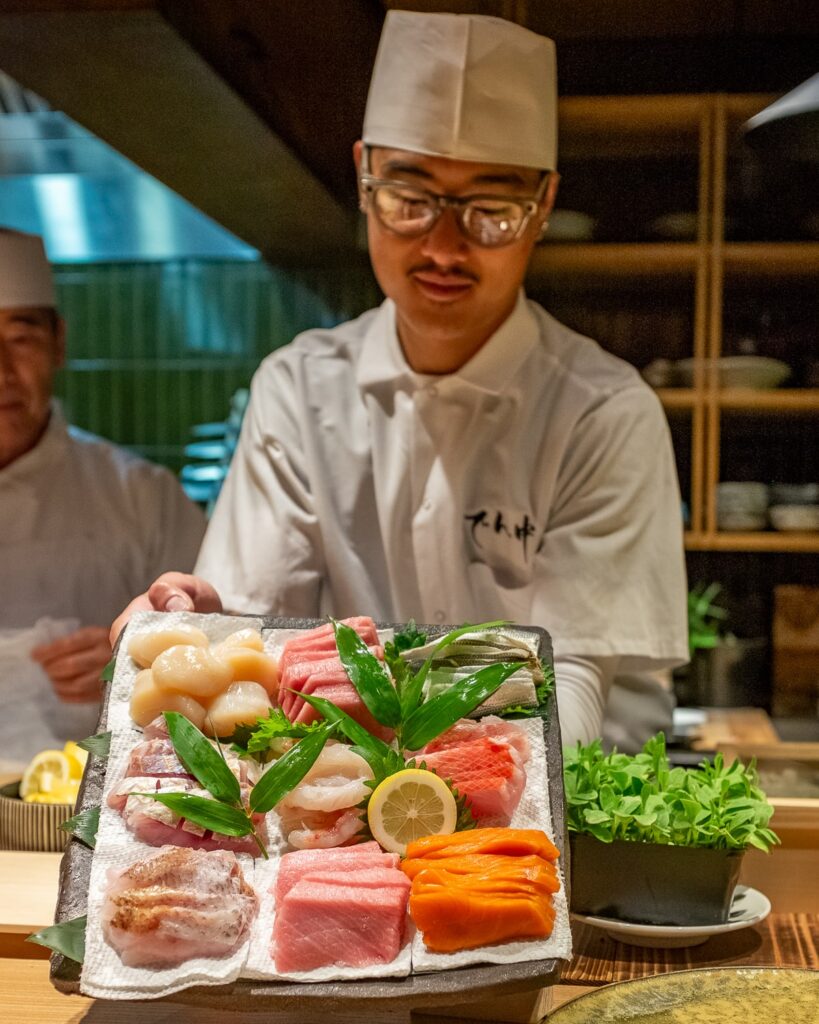
Service is taken over by Kyle Kim, the youngest cook, who, like a well-prepared sportscaster on game night, efficiently rattles off the stats for each course: the temperature of the fish (30-40°F) versus the rice (80-90°F), the origin of the wasabi (Shizuoka Prefecture), and more. He delivers each detail with the measured patience of a museum docent, occasionally clasping his hands as he further explains the dishes and how they tie into Edomae‑style traditions.
A return to Edomae
Modern sushi traces back to 19th-century Tokyo, then called Edo. Edomae (“in front of Edo”) became the term used to reference the type of quick, hand-held fish-and-rice sushi sold along the bay. Without refrigeration, vendors cured, marinated, and aging techniques to preserve the fish, and in turn, ended up defining the style.
As sushi globalized and refrigeration became common, the methods temporarily fell out of fashion, replaced by a fixation on hyper-freshness (think live tanks in fine-dining rooms). But in recent decades, Edomae has resurfaced as the craft standard, prized for how its preservation techniques coax deeper flavors and subtler textures. For purists, it’s no longer a throwback – it’s the only sushi worth seeking out.
Getting into the flow

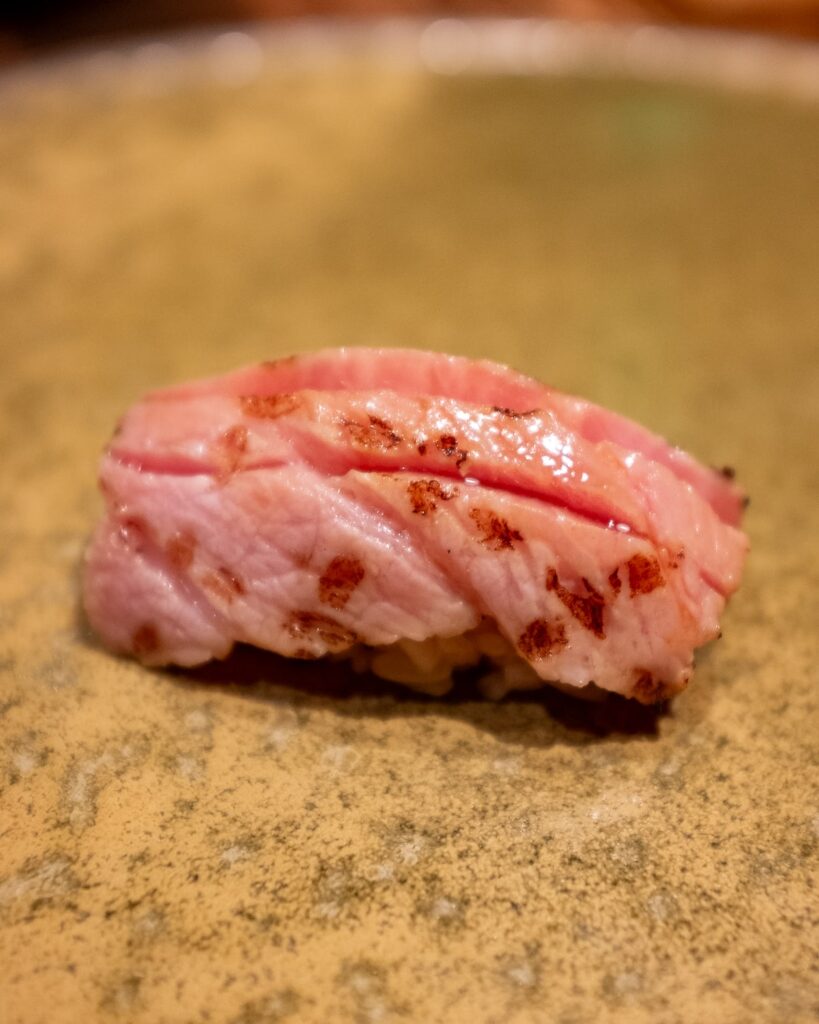
For Kizaki, which bills itself as an Edomae-style omakase experience, this translates into keeping with traditional conventions, and building the menu around nearly a dozen nigiri courses. The progression moves from delicate — snapper from Chiba Prefecture, translucent sweet shrimp from Canada — to rich and indulgent, like a silver-skinned slice of kohada, a Japanese staple and chef Kizaki’s favorite item on the menu.
But there’s still room for some modern adaptations. Rather than relying solely on Japanese fish, selections are sourced globally to meet Kizaki’s exacting standards for texture and quality. While strict Edomae traditionalists might insist on an all-nigiri menu, Kizaki sees this as impractical for the many American diners who fill his chef’s counter and expect a bit more variety — and he uses it as an opportunity to build contrast into the dinner.

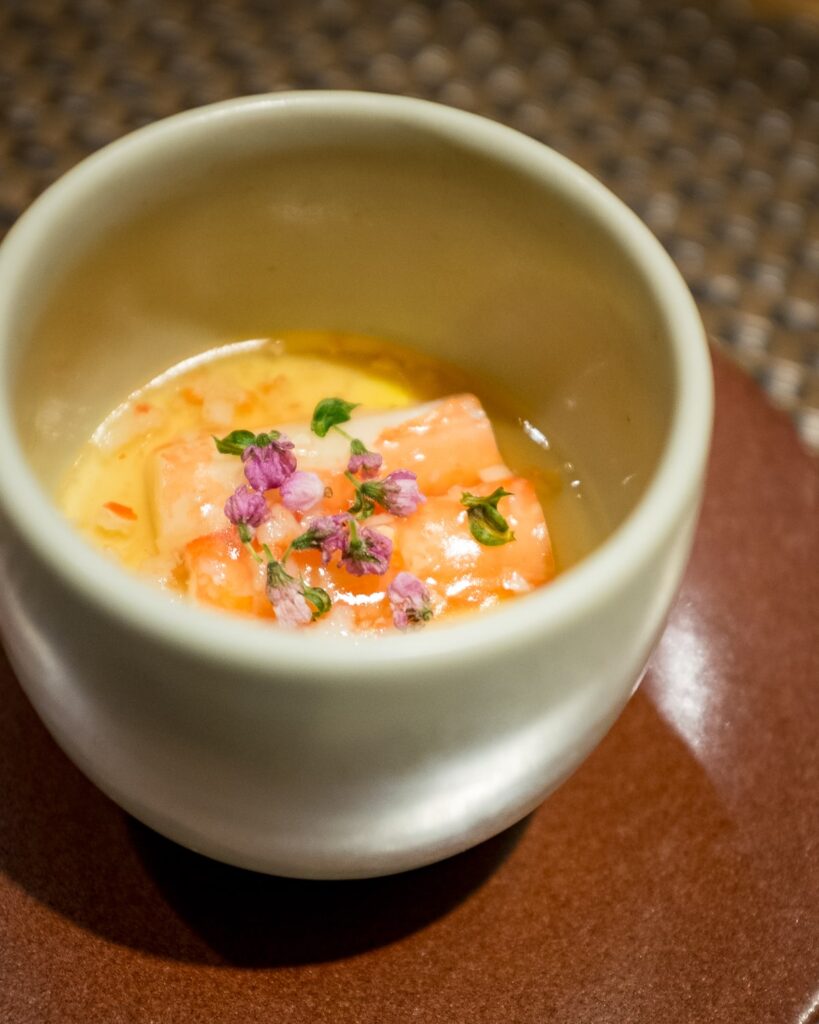
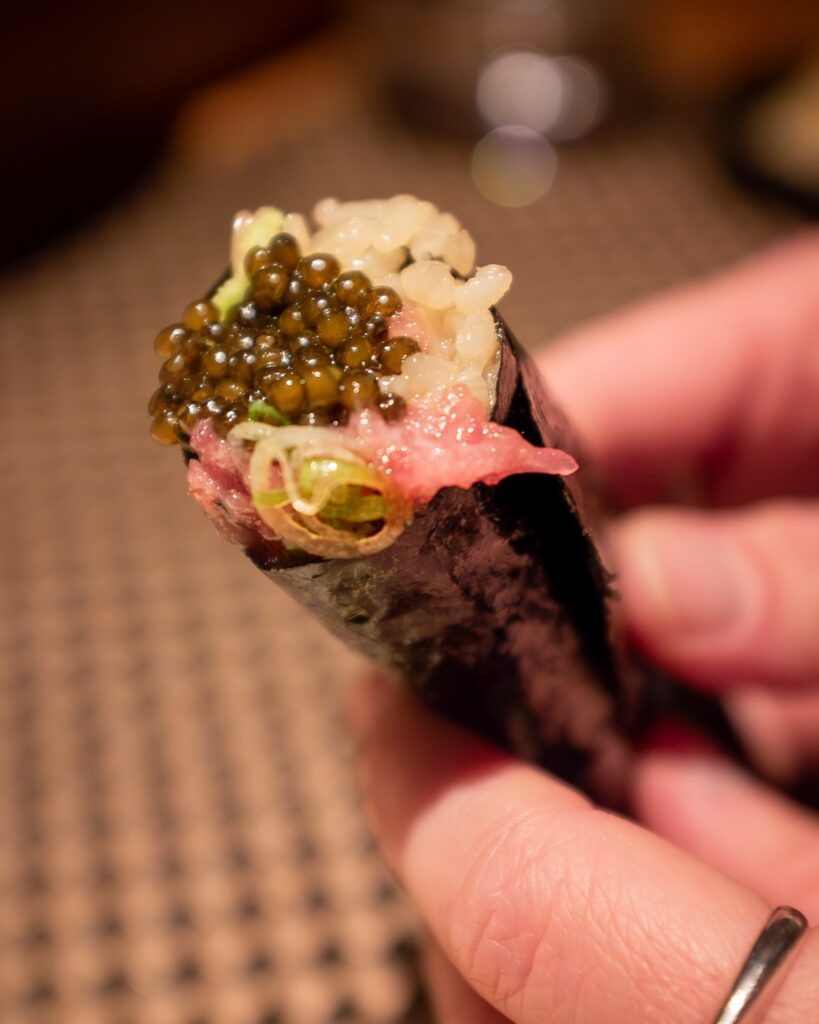
To achieve this, non-sushi courses prepared on the grill and stove are interspersed throughout the meal. A hearty freshwater eel dish is a warm starter, followed by delicately fried scallops, with a silky snow-crab chawanmushi acting as a palate opener just before the nigiri reaches its richest, most indulgent pieces.

Seats on the right-hand side of the sushi bar offer a front-row view of Kizaki’s hands moving in a choreographed, repeated rhythm: grinding fresh wasabi, shaping rice, and laying fish on top. As the first pieces of nigiri slide across the counter, a sense of urgency ripples through the diners after Kim instructs everyone to eat each piece within seven seconds for peak flavor. Like obedient schoolchildren listening to their teacher, one by one we quickly pick up the pieces and pop them straight into our mouths.
Rhythm of the craft
When I ask Kizaki how he ended up in Denver, he offers a brief, pragmatic answer that reminds me of the responses my grandfather used to give me as a kid: he needed a job, there was an opening for a sushi chef in town, and this is where he landed.
But when the conversation turns to the food, he becomes noticeably more animated. He launches into a series of lengthy explanations, starting with the Copper River salmon, which he says will likely be the last he serves for a while. The fish thrives in cold water, and now that it’s beginning its upstream run, the muscle loses its ideal texture so it’s coming off the menu. He quickly ticks off the list of his daily shipments from Japan, Mexico, and Canada, and describes the sushi rice grown on his own plot in Japan, seasoned with red vinegar.
Each story hints at the obsessive care behind every element on the plate. And yet, for a man who has spent a lifetime planning exactly where and when to source the best fish each day of the year, this meticulous attention has become a preternatural routine.
Even though the food is serious, Kizaki isn’t above having a little fun, playfully arranging penguin figurines in front of guests or signing menus at the end of the meal with a smile, sliding each dish across the bar like a gift.
Flawless execution, from start to finish

The courses flow seamlessly, each bite displaying Kizaki’s relentless focus on quality, right through to the end of the meal, which culminates with tea and a two-course dessert. At $225 per person, it’s a splurge – but right now, it’s one of Denver’s finest.
The details
Kizaki
1551 S Pearl St, Denver, CO 80210
Omakase at the counter or table is $225 before tax. Drinks, additional sushi, and gratuity are not included. Reservation times are at 5pm and 8pm.
Reservations open on the 15th of the prior month (for example, October bookings go live September 15). Guests can choose between the chef’s counter seating – where the action unfolds – or standard seating in one of two enclosed booths opposite the bar. I fully recommend booking a counter seat, and if you can, request to sit on the right side in front of Chef Kizaki.
Dietary restrictions should be confirmed well in advance. Since Edomae-style sushi relies on many preservation techniques done days and weeks in advance, substitutions may not be possible.
Disclosure: This meal was hosted. However, the restaurant has no influence over my coverage, which remains independent.
